Do you want fast, clean (accurate) measurements on high-speed signals?
No time to solder the probe tip to the device?
Where is the problem of uncertain high-speed design coming from?
These are the problems that engineers often encounter. As time pressures get bigger and bigger, and occasional problems prevent the project from completing, you need a fast, easy, high-performance method to measure high-speed signals.
The traditional way to capture signals on an oscilloscope has always been to use a handheld oscilloscope probe. This type of spot probe is trustworthy and has many advantages, such as the ability to quickly scan a series of signals by moving the probe tip between different test points. If you don't worry about the fidelity of the measurement, then this way of browsing works well because it is enough to see the DC voltage level or the working clock. If more detailed analysis or higher measurement fidelity is required, many engineers will choose to solder the probe tip to the board.
Now, thanks to the introduction of the Tektronix P7700 probe, engineers have a new option to connect to a high-bandwidth differential probe or TriModeTM probe using a sophisticated point probe tip. With the new high-bandwidth spot probe tip, you can quickly and easily move the probe between test points while still maintaining measurement fidelity.
Physical challengeYou might say: I need to detect very small circuit features and components. My component size is 0201, and the differential pair may reach 14 mils (0.35mm) recently. The current component size is so small, the board density is so high, and the contact test points are extremely challenging. In addition, the test point path is the via on the back of the BGA package or the decoupling capacitor between the larger components. The board design attempts to package as many functions as possible into the device, as long as the PCB design rules allow, the path spacing will be as close as possible. Another challenge when trying to probe signals is access to these "path groups."
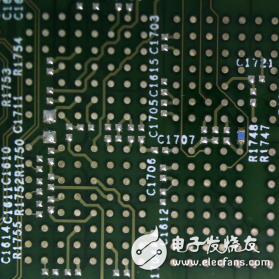
The path group on the back of the BGA package device.
How close is the probe tip to the desired test point, not any other adjacent contacts? Taking the 0201 resistor as an example, the contact on the device is 0.004†x 0.012†(0.1mm x 0.3mm), so the diameter of the probe tip must be “1mm, the contact point should be small enough to log in to the device lands (~.008). â€/~0.2mm). If the mechanical pen lead shown in the figure below is the tip of the probe, it is too big to achieve reliable contact. Similarly, the sharp toothed curette shown in the figure below is sharp. The tip is too big to log in and paste the soldering pad of the resistor.
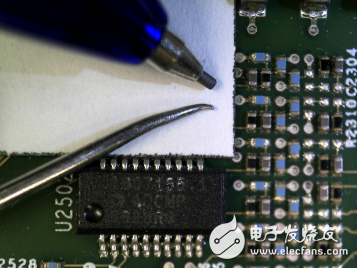
The tip size is compared to the SMT device.
The Tektronix P77BRWSR has a probe tip diameter of less than 0.01†(0.25mm) and four sharp hooks at the end of the tip for a firm contact with the SMT metadevice lands, closely spaced paths and narrow spacing. Differential pair.
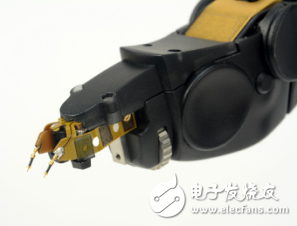
Tektronix P77BRWSR Spot Probe Accessories.
Stay connectedWe assume that the browser's probe tip is small and pointed, so what other factors do you consider when deciding which browser to use? The following words are quoted from some engineers who use point probe probes. I believe you are familiar with these words:
“When I browse the signal, I lose the connection or accidentally move to another pin.â€
“When browsing the signal, I want to maintain positive pressure on the tip.â€
Obviously, it is very important that the browser is firmly connected and always connected to the device, especially if it needs to extend to the oscilloscope while still staying connected to the signal. Spotting sharp points on the tip of the probe helps achieve this.
The hooks on the P77BRWSR are small enough and sharp enough to embed metal contacts such as solder joints or copper wires.
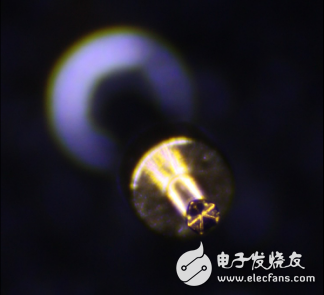
A close-up of the Tektronix P77BRWSR spotting probe tip showing the hook at the end of the tip.
The browser also has a "spring sorghum" pin tip that can be adjusted on an uneven surface to keep in contact when the handle on the spot probe is released. The video below shows this operation and features.
Wide openingThe browsing signal is not just a narrow and small problem, just as an engineer told me:
“Sometimes I need a wide gap on the browser to get in touch with the signal and ground bus that are far away.â€
Current high performance browsers generally allow adjustment of tip pitch. The adjustment range may vary, so be sure to check the maximum and minimum spacing of the tip. Maximizing the adjustment range means you can use the browser to touch more signals on the device. The Tektronix P77BRWSR has a minimum spacing of 0 and a maximum spacing of .21†(5.3 mm).
Note that the probe's high frequency response changes slightly when adjusting the spacing of the probe tip. To achieve maximum signal fidelity, be sure to check how the probe manufacturer recommends correcting the frequency response based on the degree of tip opening.
Test point viewing capabilityThere is another factor that may be very obvious, but it is often overlooked and not to make the mistake of the engineer:
"The body of the spot probe has blocked the line of sight, and I have to turn it up to see the point from different angles."
Although product technical information is rarely mentioned, it is a key requirement for quick and easy measurement to see the browser tip. When evaluating a high-performance browser, the tip should be able to extend and retract from the browser body. You should check to see the tip clearly from as many angles as possible so that you don't have to scroll or flip the device to see the probe's contact point.
The tip of the Tektronix P77BRWSR extends from the point probe body and is easy to see. It also includes an LED headlight that can be turned on to clearly see the probe connection point.
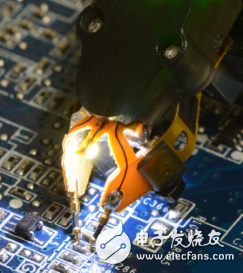
The Tektronix P77BRWSR Spot Probe tip is easily visible from all angles.
Ease of use and performanceThe P77BRWSR Spot Probe sets a new industry standard in ease of use and performance. The spot probe accessories are available for the Tektronix P7700 Series TriMode probes, which provide up to 20 GHz of bandwidth, minimizing the load on the device under test, and based on a comprehensive analysis of the S-parameter characteristics of the probe and accessories. Achieve comprehensive de-embedding measurements. The P77BRWSR provides high impedance (144kΩ DC resistance, 0.22pF AC load).
Since the fidelity of the measurement depends on the frequency response of the measuring device, the S-parameters of the accessory are stored on the spotting probe and are uploaded to the oscilloscope on the first connection. When the pitch of the probe tip changes, the frequency response is automatically adjusted according to the pitch width. You don't have to worry about the measurement because the pitch is adjusted to reduce the accuracy.
What problems do you encounter when measuring a high-speed design with a spot probe? How did you overcome these challenges?
Single Phase Portable EV Charger
Single Phase Portable Ev Charger,Portable Electric Car Charger,Portable Electric Vehicle Charger,Portable Ev Car Charger
Yangzhou JERI New Energy Co., Ltd. , https://www.jrevcharging.com